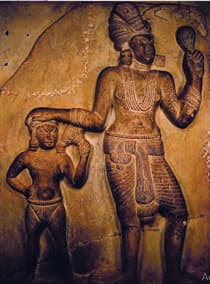Here is an excerpt of a mantra from the Rig veda, which was probably inserted in the text c. 1000 BCE, to be chanted by the priest while conducting the marriage ritual. It is used in many Hindu weddings even today: I free her from here, but not from there. I have bound her firmly there, so that through the grace of Indra she will have fine sons and be fortunate in her husband’s love. Indra was one of the principal deities, a god of valour, warfare and rain. “Here” and “there” refer to the father’s and husband’s house respectively.
In the context of the mantra, discuss the implications of marriage from the point of view of the bride and groom. Are the implications identical, or are there differences?

Important Questions on Kinship, Caste and Class Early Societies (C. 600 CBE-600 CE)
These are the names of several generations of Satavahana rulers, recovered from inscriptions.
Raja Gotami-puta Siri-Satakani, Raja Vasithi-puta (sami-) Siri-Pulumayi, Raja Gotami-puta sami-Siri-Yana-Satakani, Raja Madhari-puta svami-Sakasena, Raja Vasathi-puta Chatarapana-Satakani, Raja Hariti-putaVinhukada Chutukulanamda-Satakamni, Raja Gotami-puta Siri-Vijaya- Satakani
How many Gotami-putas and how many Vasithi (alternative spelling Vasathi)-putas are there?

How has the sculptor shown the difference between the chief and his follower?
The city, bursting like the ocean, packed with hundreds of mansions, displayed with its gateways, arches, and turrets like massing clouds the splendour of Great Indra’s city.
Do you think Lal’s finds match the description of Hastinapura in the epic?
Explain why patriliny may have been particularly important among elite families.
